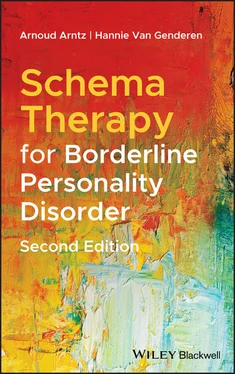Hannie van Genderen - Schema Therapy for Borderline Personality Disorder
Здесь есть возможность читать онлайн «Hannie van Genderen - Schema Therapy for Borderline Personality Disorder» — ознакомительный отрывок электронной книги совершенно бесплатно, а после прочтения отрывка купить полную версию. В некоторых случаях можно слушать аудио, скачать через торрент в формате fb2 и присутствует краткое содержание. Жанр: unrecognised, на английском языке. Описание произведения, (предисловие) а так же отзывы посетителей доступны на портале библиотеки ЛибКат.
- Название:Schema Therapy for Borderline Personality Disorder
- Автор:
- Жанр:
- Год:неизвестен
- ISBN:нет данных
- Рейтинг книги:3 / 5. Голосов: 1
-
Избранное:Добавить в избранное
- Отзывы:
-
Ваша оценка:
- 60
- 1
- 2
- 3
- 4
- 5
Schema Therapy for Borderline Personality Disorder: краткое содержание, описание и аннотация
Предлагаем к чтению аннотацию, описание, краткое содержание или предисловие (зависит от того, что написал сам автор книги «Schema Therapy for Borderline Personality Disorder»). Если вы не нашли необходимую информацию о книге — напишите в комментариях, мы постараемся отыскать её.
Shema Therapy for Borderline Personality Disorder
Schema Therapy for Borderline Personality Disorder
Schema Therapy for Borderline Personality Disorder — читать онлайн ознакомительный отрывок
Ниже представлен текст книги, разбитый по страницам. Система сохранения места последней прочитанной страницы, позволяет с удобством читать онлайн бесплатно книгу «Schema Therapy for Borderline Personality Disorder», без необходимости каждый раз заново искать на чём Вы остановились. Поставьте закладку, и сможете в любой момент перейти на страницу, на которой закончили чтение.
Интервал:
Закладка:
In this book we describe a treatment for patients with BPD, which, in most cases, leads to recovery from this disorder or substantial clinical improvement. Schema therapy (ST) not only leads to a reduction in BPD symptoms, but also to lasting changes in the patient's personality.
In Chapter 1, BPD is defined and described, followed by a discussion of the development of this disorder.
Chapter 2gives an explanation of ST for BPD, developed by Jeffrey Young. The treatment is based on the schema mode model. The different schema modes for patients with BPD are described in this chapter.
In Chapter 3we explain the aims and different phases of the therapy.
Chapters 4– 8discuss different treatment methods and techniques. Chapter 4involves seeing the therapeutic relationship as an instrument of change. Also the essential concept of “limited reparenting,” a central point of ST, is discussed at length.
Chapter 5describes experiential techniques that use experiencing to bring about change. These techniques are: imagery rescripting; role playing; the two‐or‐more‐chair technique; and experiencing and expressing feelings.
The cognitive techniques used in this book are described and explained in Chapter 6. As there is a great deal of literature about these techniques, they are only briefly defined. This is also the case for the behavioral techniques described in Chapter 7.
Chapter 8deals with a number of specific therapeutic methods and techniques. While these are not relevant for all BPD patients, they can be important and useful for specific patients and applications.
Chapter 9explains which techniques are the most appropriate to each schema mode. The art of addressing different modes in a single session is also discussed in this chapter.
The latest developments in the field of ST are explained in Chapter 10. In particular, Group‐ST, and ST with couples where one of the two partners has BPD, are discussed. We also briefly discuss the application of ST in day treatment and inpatient settings, the use of nonverbal therapies as adjunct to ST, and the application of ST for children and youths, and older people.
Chapter 11deals with the final phase of therapy during which the patient no longer has BPD, but perhaps retains some of the personality characteristics and/or coping strategies, which could stand in the way of further positive changes.
Chapter 12contains the summary and conclusion.
Considering that a large percentage of BPD patients are female, the authors refer to the patient in the feminine form. Although many therapists are female, for the sake of clarity the authors refer to the therapist using the masculine form.
1 Borderline Personality Disorder
What Is Borderline Personality Disorder?
Patients with borderline personality disorder (BPD) have problems with almost every aspect of their lives. They have problems with constantly changing moods, their relationships with others, unclear identities, and impulsive behaviors. Outbursts of rage and crises are commonplace. Despite the fact that many BPD patients are intelligent and creative, they seldom succeed in developing their talents. Often their education is incomplete, and they remain unemployed. If they work, it is often at a level far below their capabilities. They are at a great risk of self‐harm by means of self‐injury and/or substance abuse. The suicide risk is high and approximately 10% die as a result of a suicide attempt (Paris, 1993).
In this book, the DSM‐5 diagnostic criteria for BPD are used for the diagnosis of BPD and not the psychoanalytical definition of the borderline personality organization (Kernberg, 1976, 1996; Kernberg, Selzer, Koenigsberg, Carr, & Applebaum, 1989). The borderline personality organization includes a number of personality disorders and axis‐I disorders and is therefore far too extensive for the specific treatment for BPD that will be described here. According to the DSM‐5, patients must satisfy at least five of the nine criteria, as listed in Table 1.1, to obtain a diagnosis of BPD. The essential general feature of the DSM‐5 definition of BPD is instability and its influence on the areas of interpersonal relationships, self‐image, feelings, and impulsiveness.
Table 1.1 DSM‐5 diagnostic criteria for borderline personality disorder
Source: After: American Psychiatric Association (APA, 2013) DSM‐5.
| A pervasive pattern of instability of interpersonal relationships, self‐image, and affects, and marked impulsivity, beginning by early adulthood and present in a variety of contexts, as indicated by five (or more) of the following: |
| Frantic efforts to avoid real or imagined abandonment. (Note: Do not include suicidal or self‐mutilating behavior covered in criterion 5.)A pattern of unstable and intense interpersonal relationships characterized by alternating between extremes of idealization and devaluation.Identity disturbance: markedly and persistently unstable self‐image or sense of self.Impulsivity in at least two areas that are potentially self‐damaging (e.g., spending, sex, substance abuse, reckless driving, binge eating). (Note: Do not include suicidal or self‐mutilating behavior as covered in criterion 5.)Recurrent suicidal behavior, gestures or threats, or self‐mutilating behavior.Affective instability due to a marked reactivity of mood (e.g., intense episodic dysphoria, irritability or anxiety usually lasting a few hours and only rarely more than a few days).Chronic feelings of emptiness.Inappropriate, intense anger or difficulty controlling anger (e.g., frequent displays of temper, constant anger, recurrent physical fights).Transient, stress‐related paranoid suicidal ideation or severe dissociative symptoms. |
Prevalence and Comorbidity
BPD is one of the most common mental disorders within the (outpatient and inpatient) clinical population. Prevalence in the general population is estimated at 1.1–2.5% and varies in clinical populations depending on the setting, from 10% of the outpatients up to 20–50% of inpatients. However, in many cases the diagnosis of BPD is made late or not given at all. This might be due to the high comorbidity and other problems associated with BPD, which complicate the diagnostic process.
The comorbidity in this group of patients is high and diverse. On axis‐I, there is often depression, eating disorders, social phobia, PTSD, or relationship problems. In fact one can expect any or all of these disorders in stronger or weaker forms along with BPD.
All of the personality disorders can be co‐morbid to BPD. A common combination is that of BPD along with avoidant, dependent, narcissistic, antisocial, histrionic, and paranoid disorders (Layden, Newman, Freeman, & Morse, 1993).
Reviews and studies by Dreessen and Arntz (1998), Mulder (2002), and Weertman, Arntz, Schouten, and Dreessen (2005) have shown that anxiety and mood disorders are treatable when the patient has a comorbidity with a personality disorder. However, in the case of BPD, one must be careful to only treat the axis‐I disorder. BPD is a serious disorder that results in permanent disturbance of the patient's life with numerous crises and suicide attempts, which makes the usual treatment of axis‐I disorders burdensome. Axis‐I complaints and symptoms often change in nature and scope, making the diagnostic process even more difficult. This often results in the treating of BPD taking priority. Disorders that should take priority over BPD in treatment are described in “(Contra‐) Indications” (see Chapter 2).
Development of BPD
The majority of patients with BPD have experienced sexual, physical, and/or emotional abuse, and emotional neglect in their childhood; sexual abuse in particular between the ages of 6 and 12 (Herman, Perry, & van der Kolk, 1989; Hernandez, Arntz, Gaviria, Labad, & Gutiérrez‐Zotes, 2012; Lobbestael, Arntz, & Bernstein, 2010; Ogata et al., 1990; Weaver & Clum, 1993). It is more problematic to identify emotional abuse and neglect in BPD patients than to identify sexual or physical abuse. Emotional abuse and neglect often remains hidden or not acknowledged by the BPD patient out of a sense of loyalty toward the parents or due to a lack of knowledge of what a normal, healthy childhood involves. These patients don't know what they missed, because they never experienced feelings of being loved, accepted, and cared for. When someone tries to give them love and acceptance later in life, they sometimes react negatively toward that person (i.e., the therapist).
Читать дальшеИнтервал:
Закладка:
Похожие книги на «Schema Therapy for Borderline Personality Disorder»
Представляем Вашему вниманию похожие книги на «Schema Therapy for Borderline Personality Disorder» списком для выбора. Мы отобрали схожую по названию и смыслу литературу в надежде предоставить читателям больше вариантов отыскать новые, интересные, ещё непрочитанные произведения.
Обсуждение, отзывы о книге «Schema Therapy for Borderline Personality Disorder» и просто собственные мнения читателей. Оставьте ваши комментарии, напишите, что Вы думаете о произведении, его смысле или главных героях. Укажите что конкретно понравилось, а что нет, и почему Вы так считаете.












